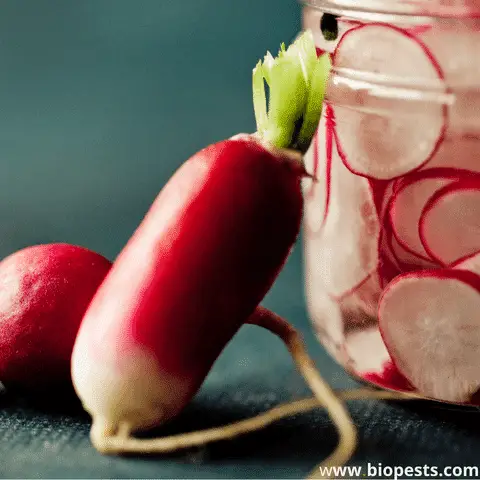Although nutritious and flavorful, radishes often get a bad rap. This humble root vegetable has caused quite a scene in the US over the years, even featuring in the Daily Gazette and on Fox 59 News. They were also the reason behind some 911 calls in the past – all because of their smell!
All radishes contain a natural, colorless gas called methyl mercaptan, also known as methanethiol, that causes them to smell bad. Methyl mercaptan is an organic sulfur compound that, when released, has a distinct odor that smells like rotten eggs or cabbage.
All types of fresh radish, like Cherry Belle, Red Globe, or Daikon, have a distinctive yet very mild aroma. Some might even say it is relatively odorless. However, radishes that are pickled, spoiled, or in the midst of decomposing have a much more pungent smell that is hard to ignore. People have compared the scent to sewage water, propane, gym socks, excrement, and … dead bodies!!

The Science Behind The Radish Smell
Radish roots contain in their composition essential oils, which cause their specific odor and taste. These oils define the characteristics of raw vegetables, playing a vital role in their particular flavor and smell. The oils in radishes contain allyl mustard oil, glycoside synalbin, and methyl mercaptan – the latter gives radishes their distinct odor.
Methyl mercaptan is a harmless, natural gas also found in many other foods, like asparagus, onions, and some nuts and cheeses. This organic substance is also present in animal and human bodies, most identifiable through the smell when you urinate or experience lousy breath or flatulence.
Methyl mercaptan is an effective odorant because it releases strong smells that are detectable by humans at a concentration of as small as ten parts per billion. Most mercaptans release smells that resemble rotting cabbage or garlic. However, people experience the resulting aromas differently, so others would agree that the smell is more like dirty socks or smelly feet.
Radishes can smell particularly bad when they have gone off or are in the process of decomposing. During these stages, methyl mercaptan is released from the decaying organic tissue and can produce a more pronounced aroma than when fresh.
How Can You Combat The Smell Of Radishes?
As much as you love radishes for their spicy taste and nutritional value, the smell is sometimes too pungent to bear. Other times, it is the taste that is really “off”, when radishes taste like soil.
To reduce the aroma, you can try salting and washing your radishes. Steaming or cooking the radishes with other vegetables will also help, but be aware that this might draw out the peppery taste that so many people are after.
Some claim that peeling radishes will also reduce the rank odor, but this method has not undergone rigorous testing, nor has any reliable sources confirmed its effectiveness.
Is It OK To Eat Smelly Radishes?
If your radishes are fresh, then you can eat them. It is worth noting that the aroma of radishes can be more robust when you pickle them, for example. Also, some varieties of radish have a more distinct smell than others. That does not have to concern you – the aroma is entirely natural.
It is also worth remembering that consuming a lot of radishes can irritate your digestive tract and cause flatulence and stomach cramps. Radishes can also cause allergic reactions in some people, resulting in a hive break-out. These physical signs do not necessarily correlate to the foul smell of radishes nor indicate that you ate a lousy radish. It might just be your body’s reaction to a perfectly fresh one.
However, if radishes smell bad and accompany additional signs of deterioration, you should discard them. Suppose you have already consumed a radish that was not fresh; keep monitoring your symptoms. Sometimes, a slightly wilted radish is harmless, although it won’t provide you with its usual nutrients. Still, you might experience dehydration, diarrhea, or fever in more severe cases.
How To Test If Radishes Are Fresh
Radishes are available year-round but checking if they are of good quality when you purchase them is vital. Assessing the freshness of radishes is similar to how you would check other fruits and vegetables.
Sometimes the odor is the first thing that you notice. The smell of fresh radishes is distinct yet relatively subtle, which is not a cause for concern. The scent can point to the radish being off if the smell is incredibly potent. However, first, determine whether the odor is just the natural aroma of the radish and then take further steps to confirm your suspicions.
The next thing to do is to touch the radishes to determine their texture. A fresh radish should be firm and crisp, which will be especially obvious when you cut through them. If a radish feels soft or soggy when you gently press them, you should refrain from eating it as it might be off.
The final clues will be in the visual appearance of the radishes. Any signs of decay, like mold, rot, or extensive discoloration (white or brown scars or black spots), should be a warning sign that the radish might not be fresh. The greens should also look new and green, not limp or yellow if they are still on the radishes.
Storing Radishes
It is vital to, firstly, consider the biological structure of radishes as it relates to storage. When in the ground, the radish roots pull moisture from the surrounding soil to grow. The greens, in turn, extract all the energy, nutrients, and water from the roots, i.e., the part you tend to use in your cooking. This process continues when you harvest radishes, and the greens remain dependent on the roots.
When preparing radishes for storage, you must remove the greens (leaves) from the roots so that they will not remove any more moisture from them. The last thing you want is dehydrated radishes. So, cut the greens off, but do not discard them. Radish leaves are flavorful and can be used easily in soups and salads, sauteed in a pan, or even converted into a pesto.
How To Store Fresh Radishes
First, clean the radishes by cutting off the smaller, white roots still protruding from them. Take a plastic bag and place a piece of damp paper towel flat down inside the bag. Put your radishes inside the plastic bag on top of the moist paper towel and cover it with another wet paper layer. You can repeat the steps by adding more layers of radishes, as long as you add damp paper towels between them.
Remove most of the air from the plastic bag and seal it. You want to ensure that your radishes remain moist and that no air gets in that will dry them out. Place the plastic bag in the crisper drawer of your fridge, where your radishes will happily remain fresh depending on their variety. If the radishes are from the spring varieties, they will last 4-7 days. If they are winter radishes, they can last for 2-3 weeks.
How To Store Pickled Radishes
Pickled radishes can last long in your fridge but are best if eaten within three months. After three months, they lose their texture, giving you softer radishes that lack a nice crunch.
During fermentation, radishes will give off CO₂, which causes a highly intense aroma. It is thus best to ferment the radishes in a garage, basement, or an area far away from your main living space. Once you are happy with how the radishes taste, you can put them in the fridge. Just make sure to keep the jar tightly sealed. The tiniest opening will allow the odor to escape into your fridge.

As soon as you notice any bubbling in the jar, a bulging lid, a color change, or a difference in taste, it would be best if you discarded your pickled radishes. Even though pickling helps to extend the life of your radishes (4 months if unopened), you should check it regularly to monitor whether it is safe to consume. If you open your pickled radish jar, it will remain safe to eat for 1-2 weeks, after which you should discard it.
Make sure you use quality jars with an air-tight lid like these which are available on Amazon.
How To Store Cooked Radishes
Freezing radishes is the perfect solution for long-term storage. It is also a good idea for meal prep, making it quicker and easier to use in your dishes when you need them later. You can put blanched or cooked radishes in containers, zipper bags, or vacuum seal bags to keep for long-term storage. Remove any excess air from the pack to prevent ice crystals from forming.
If you are prepping radishes in advance for use later, cut the radishes into halves, slices, or quarters. Then blanch the radishes for 2-3 minutes, slowing down the enzymatic process to save the plant tissue and keep the color vibrant. Immediately after you blanched them, put the radishes in an ice bath and then flash freeze for at least 6 hours.
Conclusion
Fresh radishes have a crisp texture and a peppery hot flavor, making them popular served as hors d’oeuvres, complements to salad or sandwiches, or garnish. The only dark cloud within this silver lining might be the distinct smell that makes people steer clear of them.
However, do not let the smell discourage you from utilizing it in your cooking. Like onions, asparagus, nuts, and some cheeses, radishes smell from a natural gas called methyl mercaptan embedded in their DNA. This organic component is harmless and only exacerbated when radishes are pickled or deteriorating. In that case, you might have to discard them.
If you are a radishes lover, check out these articles!
Why Radishes Get Worms? Tips On How To Solve This Problem
Which Radishes Are The Spiciest? What Makes Them Spicy
Radish Vs. Horseradish. What’s The Difference?
Why Do Radishes Taste Like Soil? Here Is Why
Some of the links above are affiliate links, meaning, at no additional cost to you, I will earn a commission if you click through and make a purchase.

